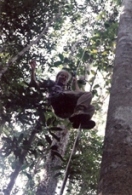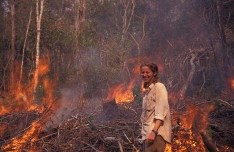
 I have researched a variety questions in a variety of settings ranging from tropical rainforests to temperate arid systems, but all of my research focuses in some way on the effects of disturbances on ecosystems. My first research experience was working as a field technician on a project that estimated the carbon balance of a rainforest in Borneo in order to quantify its carbon-offset potential. I later returned to Borneo for my masterís research where I studied the biomechanical properties of lianas (woody vines).
I have researched a variety questions in a variety of settings ranging from tropical rainforests to temperate arid systems, but all of my research focuses in some way on the effects of disturbances on ecosystems. My first research experience was working as a field technician on a project that estimated the carbon balance of a rainforest in Borneo in order to quantify its carbon-offset potential. I later returned to Borneo for my masterís research where I studied the biomechanical properties of lianas (woody vines).
 I conducted my doctoral research in the dry tropical forests of Bolivia. My research there focused on the effects of fires of different intensities on forest regeneration and soil physical and chemical properties. I also studied forest succession over longer time scales by comparing forest structure and composition along a chronosequence of secondary forests ranging in age from 1-50 years old.
I conducted my doctoral research in the dry tropical forests of Bolivia. My research there focused on the effects of fires of different intensities on forest regeneration and soil physical and chemical properties. I also studied forest succession over longer time scales by comparing forest structure and composition along a chronosequence of secondary forests ranging in age from 1-50 years old.
Fire and old-growth pinyon-juniper woodlands: Since moving to western Colorado, I have been studying the fire history and woodland dynamics of pinyon-juniper forests in the Colorado National Monument. Environmental science students and I mapped the estimated ages of pinyon pine and juniper trees across the mesa tops of the Colorado National Monument and found out that large, landscape-scale fires have not occurred in this area for many centuries. I am currently collaborating with the USGS and the NPS to use remote sensing to detect cheatgrass and other early season invasive plants across large scales. This technique will allow us to document the interaction between cheatgrass and large fires in pinyon-juniper woodlands on the northern end of the Uncompahgre Plateau. I am also working with students to examine the dynamics of the ecotone between old-growth pinyon-juniper woodlands and sage shrublands.
Effects of the tamarisk leaf beetle on riparian vegetation: I am also collaborating with the Palisade Insectary to document changes in plant composition in tamarisk stands as they are defoliated by the biocontrol Diorhabda carinulata , the tamarisk leaf beetle.
Online guide to flora of Mesa County: Collaborating with students and faculty in the Department of Biology, I have also helped to develop an Online guide to the flora of Mesa County.
